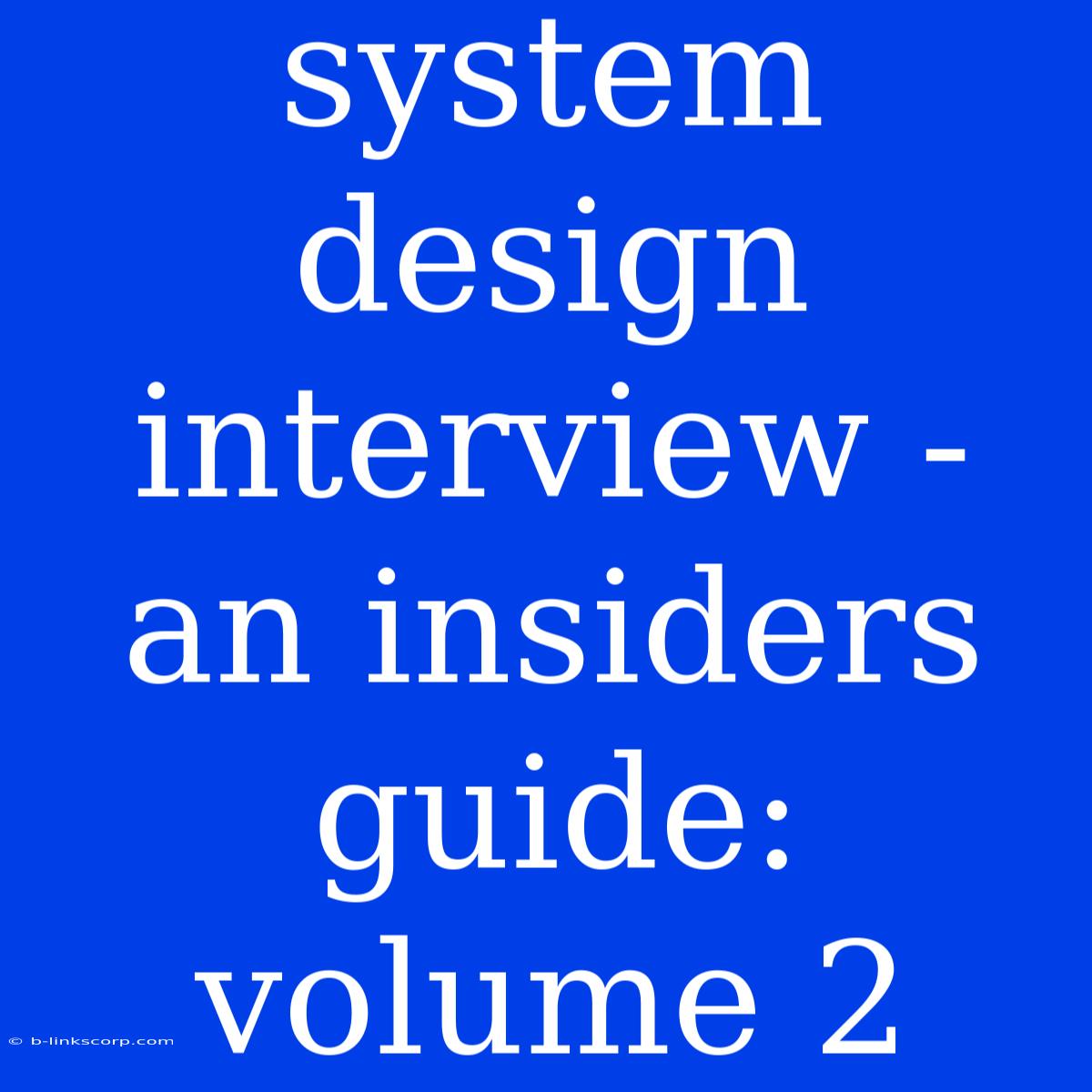System Design Interview - An Insider's Guide: Volume 2
Welcome back to the second volume of our insider's guide to system design interviews! In this installment, we'll delve deeper into the intricacies of designing scalable, robust, and efficient systems. We'll be building upon the foundation laid in the first volume, exploring key concepts and best practices to help you ace your next system design interview.
1. Building on the Foundation: Scaling Strategies
We've discussed the importance of scalability in the first volume. Now, let's explore various scaling strategies in detail:
a) Vertical Scaling: This approach focuses on increasing the resources of a single server, such as CPU, RAM, or storage. It's a simpler option, but it can become expensive and limited when the demand exceeds the capacity of even a powerful server.
b) Horizontal Scaling: This strategy involves adding more servers to handle the workload, effectively distributing the traffic across multiple machines. Horizontal scaling is often more cost-effective and flexible, especially when dealing with large and unpredictable traffic fluctuations.
c) Distributed Systems: Utilizing multiple interconnected servers to distribute data and workload creates a system that is fault-tolerant and can scale seamlessly. This approach requires careful design and implementation to ensure consistency and data integrity across the distributed components.
d) Load Balancing: This technique distributes incoming traffic across multiple servers to prevent overload and ensure optimal performance. Load balancers act as traffic controllers, directing requests to available servers based on defined criteria like server load, response time, and capacity.
e) Caching: This technique stores frequently accessed data in memory to reduce the need to fetch it from slower sources like databases. Caching can significantly improve system performance and responsiveness by reducing latency.
f) Content Delivery Networks (CDNs): CDNs cache content in geographically distributed servers to serve users from the nearest location. This strategy improves content delivery speed and reduces latency for global audiences.
2. Diving Deeper: Database Choices and Design
Choosing the right database for your system is crucial for optimal performance and scalability. Here's a breakdown of popular database types:
a) Relational Databases (RDBMS): These databases store data in structured tables with predefined relationships. RDBMS are best suited for structured data, complex queries, and maintaining data integrity through transactions. Examples include MySQL, PostgreSQL, and Oracle.
b) NoSQL Databases: These databases are designed to handle large volumes of data, often unstructured, with flexible schema and high availability. They are well-suited for applications with rapid data growth, diverse data formats, and high read/write performance requirements. Examples include MongoDB, Cassandra, and Redis.
**c) Data Modeling: ** It's crucial to understand how data interacts within your system and choose appropriate database schema to optimize performance and efficiency. Effective data modeling involves defining relationships between entities, ensuring data integrity, and facilitating efficient retrieval.
3. Mastering the Art of System Design: Key Concepts and Best Practices
a) Design for Failure: Real-world systems are prone to failures. Designing for failure means anticipating potential points of failure and implementing mechanisms to mitigate their impact. This includes techniques like redundancy, fault tolerance, and graceful degradation.
b) Monitoring and Logging: Continuously monitoring system performance and logging events is essential for identifying bottlenecks, detecting anomalies, and debugging issues. Monitoring systems should provide real-time insights into key metrics like resource usage, latency, and error rates.
c) Security: Security should be a primary consideration throughout the design process. Implement measures to protect sensitive data, prevent unauthorized access, and ensure data integrity.
d) Scalability and Performance: Choose technologies and architectures that can handle growing data volumes and user traffic. Optimize system performance by identifying bottlenecks and implementing caching, indexing, and other optimization techniques.
e) Maintainability: A well-designed system should be easy to understand, maintain, and evolve over time. Implement clear documentation, modular architecture, and standardized coding practices to facilitate future development and maintenance.
4. The Interview Process: Preparing for Success
a) Understand the Problem: Carefully analyze the requirements and the problem domain. Clarify any ambiguities and ask clarifying questions to ensure a clear understanding of the desired system.
b) Design Iteratively: Don't try to design the perfect solution upfront. Instead, start with a basic solution and iterate upon it by incorporating feedback and adding complexity as needed.
c) Communication is Key: Clearly articulate your design choices, trade-offs, and rationale. Engage in open communication with the interviewer, asking questions and seeking clarification when needed.
d) Focus on Core Concepts: Don't get bogged down in specific technologies or implementation details. Focus on fundamental system design principles, data structures, algorithms, and scalability strategies.
5. Practice Makes Perfect: Level Up Your Skills
- Work through real-world system design problems: Practice designing systems for common applications like e-commerce platforms, social media networks, search engines, and ride-sharing services.
- Participate in online coding challenges: Websites like HackerRank, LeetCode, and Codewars offer a wide range of coding challenges that test your problem-solving and design skills.
- Study system architecture diagrams: Familiarize yourself with common architectural patterns and diagrams, such as layered architecture, microservices, and cloud-based deployments.
- Read industry blogs and articles: Stay up-to-date on current trends and best practices in system design by reading blogs, articles, and publications from leading technology companies.
Remember: System design interviews are about demonstrating your ability to think critically, analyze problems, and design scalable, efficient, and robust systems. With practice, preparation, and a clear understanding of core concepts, you can excel in these interviews and land your dream job!

